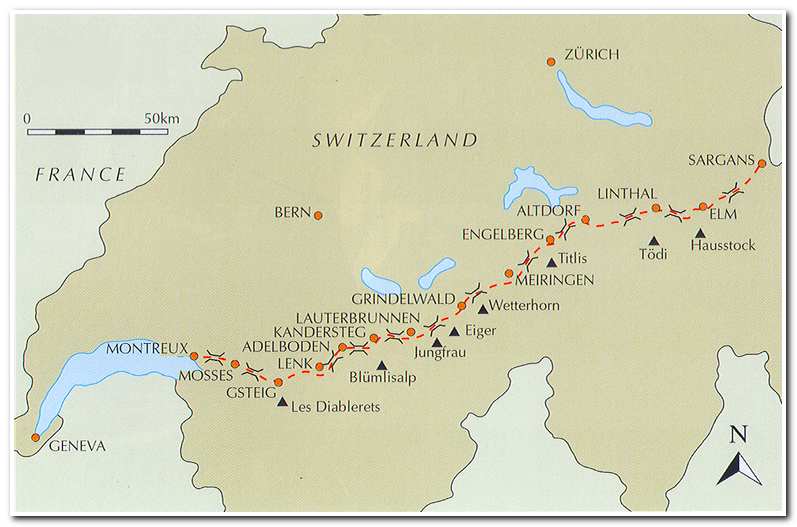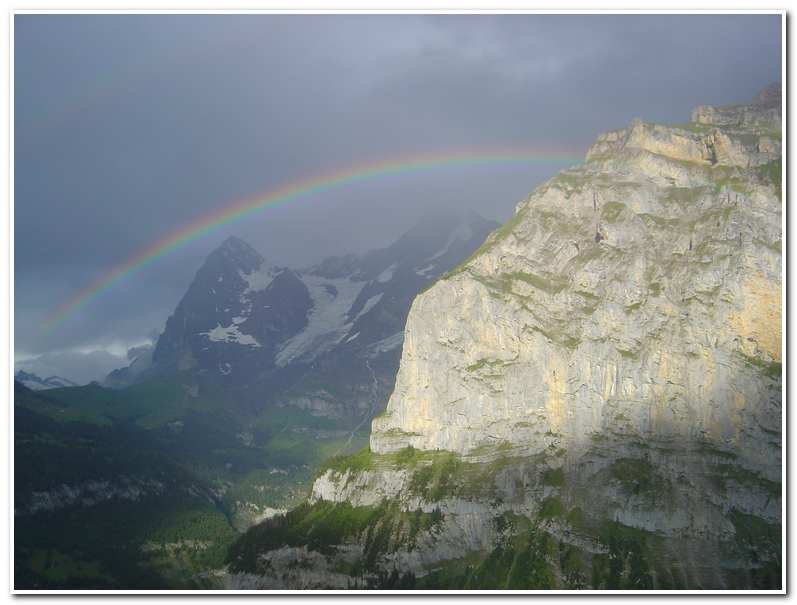The Swiss Alpine Pass Route
Sargans to Montreux
2005 – 2006
The Swiss Alpine Pass Route across Switzerland makes a complete east to west traverse from the town of Sargans, on the Swiss border with Liechtenstein, to Montreux on the shores of Lake Geneva and the French border. It passes through 202 miles of mountains and valleys, crosses 16 mountain passes and gains over 59,000 feet in 15 daily stages.
Each day the hiker wanders the trail for hours through valleys filled with wild flowers, streams and waterfalls. Then, after leaving the valley behind, the trail rises up past remote farms, hay barns and pastures to high alpine meadows. Soon the hiker climbs even higher, past mountain tarns, glaciers and past the great peaks of the Bernese Oberland. After reaching one of the many high passes he begins his descent back down into the next valley before stopping for the night at one of the picturesque villages along the way.
Every one of the passes crossed by the route has its own special character: From the remote, slender crest of the Richetli to the broad, crowded Kleine Scheidegg with its close-up view of the Eiger, Monch and Jungfrau. From the narrow rocky notch of the Bunderchrinde to the open grass saddle of the Blattipass that overlooks the Bernese Oberland. From the Hohturli with its awesome cliffs and glaciers nearby, to the Col de Chaude which overlooks Lake Geneva far below.
It is not only the passes that make this route so memorable, but the villages visited on the way. These add their own character to the trip. After hiking hard all day long you come down, at the end of the day, to delightful little villages like Weisstannen and Elm, to Griesalp or Gsteig. These are flower bedecked villages whose balconies look out at the very mountains you have been hiking through all day.

The Route. The first stage of the route is a fairly easy one that climbs up into the mountains from low-lying Sargans, on the Rhine River. It then works its way southwestward into the wooded Weisstannental, a peaceful valley with little population but for the small town of Weisstannen. I spent the first night there. The next day I made for the head of the valley and ascended the steep trail up over 4000 feet to the Foopass. It was a 7300 foot saddle in a ridge linking the Foostock with Kleine-Schiben, followed by a long descent to the village of Elm in the Sernftal valley.
The Sernftal is hemmed in by remote ridges accessed by hidden hanging valleys. To get from Elm to Linthal the trail ascends high pastureland. It crosses over the Richetlipass north of the Hausstock, a dominant peak that overlooks the next valley leading to Linthal.
From Linthal the trail parallels the road that climbs out of the village and cuts through the former glacial valley of Umer Boden. This is a cattle raising pastureland dominated by the snowy Clariden. Beyond Umer Boden lies the Klausenpass which is crossed by a road leading to Altdorf.
Altdorf is famed as Williams Tell’s town, and a statue in the central square commemorates the folk hero. Just across the valley to the southwest lies Attinghausen, a small village that lies at the foot of the long climb to the Surenenpass (7370 feet). From the pass is a great view of the glaciated Titlis which is visible nearly all the way down to the town of Engelberg.
From Engelberg, the trail ascends to the Engstlensee then over the Jochpass before descending to Meiringen, site of Reichenbach Falls, of Sherlock Holmes fame. Meiringen also marks the beginning of the Bernese Oberland portion of the route. From here to Gsteig these fantastic mountains dominate the scene.
Grindelwald is the next goal and it is reached by way of a valley walk alongside the beautiful Engelhorner stream before rising to Grosse Scheidegg, a broad grass covered col leading to the famous alpine village of Grindelwald at the base of the Eiger.
The walk from Grindelwald to Lauterbrunnen by way of Kleine Scheidegg is a world classic. The route passes the Eiger, Monch and Jungfrau as it crosses over the pass and descends steeply past the village of Wengen. It then extends further down to the valley floor to the village of Lauterbrunnen.
From Lauterbrunnen the trail ascends to the cliff side village of Murren and then continues up past the Schilthorn to the Sefinenfurke. After passing through the Sefinenfurke, the route makes a very steep descent on its western side into the Kiental. Here fixed cables on scree slopes provide security until the trail eases, crossing beautiful heather alps and at last enters the little enclave of Griesalp.
The next stage crosses the Hohturli and is one of the most challenging on the entire route. At 9110 feet it’s the highest col. The ascent is up a valley and then the steep scree slopes into a series of rocky spires. After weaving a route through these spires a final steep laddered ascent leads to the rocky cleft just below the Blumlisalp Hut. After resting here the day ends with a tortuous 5250 foot descent to the town of Kandersteg.
From Kandersteg to Adelboden the trail crosses the Bunderchrinde, a narrow passage through a craggy ridge. This is the final rocky pass of the route and one of the most scenic.
The next stage goes from Adelboden, where there is a fine view of the Wildstrubel, which remains in sight for part of the walk on the next stage to the Hahnenmoos and Pommernpass and then down to the town of Lenk.
Two passes are crossed the next day. The first of these is the Truttlisberg which leads to the village of Lauenen. Then the trail continues on over the wooded Krinnen Pass which provides the first views of Les Diablerets before descending to Gsteig.
So far, most of the route from Sargans has led in a southwesterly direction, but on leaving Gsteig the route veers away from the Bernese Alps and heads due west. It first heads up the Blattipass then across a pastoral landscape before winding down to the village of Col des Mosses.
The final leg of the route meanders along the shores of Lac de l’Hongrin, and then ascends to the Col de Chaude. From there Lake Geneva can be seen nearly 4000 feet below. A final combination of forest path, track and service roads descends to Montreux and the end of the route along the shore of the lake.



